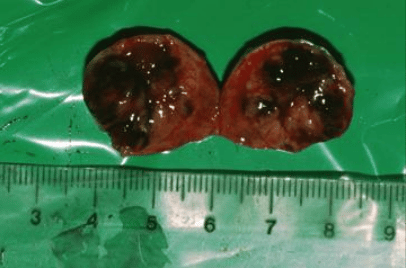Cushing’s Disease (or Equine Cushing’s Syndrome) is a complex condition associated with abnormal function of a small, hormone-producing organ, the pituitary gland, which lies at the base of the brain. For reasons we do not yet know, some horses develop enlargement (adenoma) of part of the pituitary gland (the pars intermedia), which then produces excessive amounts of hormone (adrenocorticotropic hormone, commonly called ACTH). The consequent hormonal imbalances caused in various organs and tissues result in a range of clinical abnormalities.

What are the clinical signs?
The average age of a horse or pony with Cushing’s Syndrome is 20 years, although horses as young as seven have been affected. The most striking sign, but one which is not always present, especially in early cases, is an excessively long and curly coat (hirsutism). This is caused by the hair coat not being shed normally. This ‘woolly bear’ appearance may have been preceded by several years during which the winter hair coat was not shed until very late. Many affected horses drink excessive amounts of water and produce large volumes of urine (polydipsia and polyuria). Other signs are lethargy, weight loss or an inability to maintain muscle while accumulating fat (especially on the crest and on top of the rump) and excessive sweating. Affected cases often suffer from acute or recurrent attacks of laminitis and many suffer from liver disease. Cushing’s disease can be severely debilitating and affected horses or ponies can develop severe pneumonia or other secondary infections.
How is the condition diagnosed?
In aged horses or ponies with hair coats that are several inches long and curly and there is a history of laminitis and/or excessive drinking, the diagnosis can often be made on these grounds alone. In other less obvious cases, especially in younger horses that are developing the condition, the diagnosis depends on a combination of clinical signs, blood and urine tests. ‘Classical’ cases usually have high blood and glucose levels, which can be simply and inexpensively measured by your veterinarian. However, due to the complex nature of the condition, it may be necessary to use additional specialized blood tests which look at changes in hormone levels in response to the injection of other hormones, testing hormone system function. Animals with Cushing’s Syndrome usually respond abnormally to one or more of these tests, but interpretation of results is not always straightforward, as they can sometimes appear contradictory. Your veterinarian will help you with this. Unfortunately, some of these tests carry the risk of aggravating or inducing laminitis in some cases.
Is any treatment available?
Due to the complex, multi-organ problems that can be associated with Cushing’s Syndrome, attempts at treatment must include attention to all aspects of the animal’s condition. Affected horses are more susceptible to parasites and infection so regular worming, vaccination and teeth care should be instituted. Any dietary changes will depend on the age and condition of the horse or pony, the available grazing, the presence or absence of laminitis, expectations for work, etc and should be discussed with your veterinarian. Cases with excessively long coats may sweat excessively or may take a long time to dry off after exercise and they should be clipped over their body and neck to help them dry off more quickly. In cooler weather, clipped horses and ponies may need to be blanketed.

There are two medicines that are now used to treat Cushing’s Syndrome in horses and ponies. These are called pergolide mesylate and cyproheptadine. Neither drug is totally effective in all cases and some cases do not respond to treatment at all. Treatment with either must continue for the life of the horse or pony and is not inexpensive. Treated cases must be regularly monitored with regard to their clinical signs and sometimes by repeat blood.
Your veterinarian is the best person to discuss this complex problem, to determine whether or not your horse or pony really does have Cushing’s Syndrome and if so what treatment is appropriate.
Can it be prevented?
As we do not know the cause it is not possible to prevent this condition. However, with available blood tests we are now able to recognize and treat more cases earlier and more effectively and many treated horses and ponies go on to live normal lives for many years after diagnosis and treatment.
